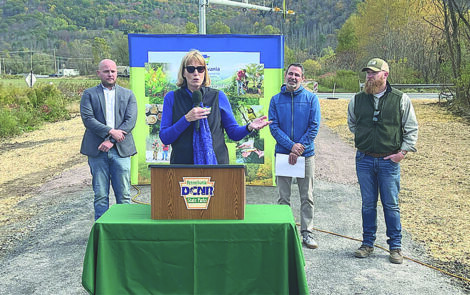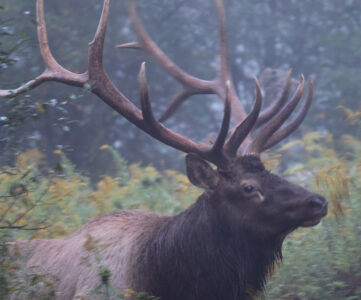Reflections in Nature: It’s time of the year where state’s deer herd population declines
During the last week of May and the beginning of June, the deer herd population in Pennsylvania will reach its peak and then begin to decline until the following May when the herd population will be at its lowest point.
The reason for the peak during the last week of May and the first week of June is due to most of the fawns are born at that time. During the remainder of the year, natural depreciation occurs as more deer die from predators, road kills, etc., than fawns have been born.
The gestation period for the whitetail deer varies from 190 to 210 days. Several factors might affect this gestation period: the age of the doe, temperature, stress, and food. I read in the Game News that the peak of the rut in the fall occurs between Nov. 14-17
An adult doe will normally give birth to one or two fawns. Occasionally, a female gives birth to three fawns; however, while working, I received a few reports about does giving birth to four or five fawns. When hearing of the five fawns, I called Pennsylvania Game Commission Biologist Abe Lang (now deceased), who had studied deer reproduction for 16 years.
Lang told me that he had documented several cases of doe deer giving birth to four fawns, but never five. I asked him if it was possible for a doe to have five fawns and he stated it was possible but not probable. He stated that at times an older deer adopts an orphaned fawn and raises it along with her fawns. He went on to say that two does will occasionally get together and raise their young, however, this occurs after the fawns are older.
Both events are rare in the wild.
Immediately before a female gives birth to a fawn, she will drive away fawns born the previous year that are still accompanying her. The spot where the doe gives birth to her fawns does not appear to be a carefully chosen area. Wherever she is when the time arrives seems to be the rule.
The entire birth of a fawn could take only ten minutes or up to hours. A young deer giving birth for the first time will generally have only one fawn, while an older doe generally has two fawns. In the case of twins, the second fawn is born within an hour, usually within ten to 20 minutes of the first fawn.
After licking her fawns, an old doe will try to lead them away from the birthplace because predators are attracted to the birth area. It usually takes an hour before the fawns can walk on their shaky legs.
At first, the doe must lie down to nurse the fawns because they cannot reach her nipples. Later, as the fawns grow, she will nurse them while standing.
Fawns will nurse heavily for nearly two months. They are completely weaned at three and a half months, and at three weeks of age, they begin to nip tender grass.
While the fawns are very young, the doe will stay away from them as much as possible. The reason for this is that the doe’s body scent would give away the fawn’s location. She returns to nurse the fawns eight to ten times in a twenty-four-hour period. When a fawn is first born it does not have any detectable scent and cannot be scented by predators. This scentless period lasts only about three weeks because, at this time, the tarsal leg glands become functional.
During this period, the fawn is alone, and people assume that they are orphaned. As with all young wildlife a fawn is always hungry and does not know that humans mean danger. A fawn lying in the grass will allow a person to come near, touch and even hold it.
But when you are ready to leave, the fawn will most likely follow you. After all, your presence means a meal to the fawn. The fawn might even bleat as you leave, a sure sign that the fawn is abandoned. In all the studies done by wildlife agencies across the land, not one doe has ever abandoned her fawn.
The well-meaning people pick up the fawn and take it home. After all, it is abandoned and needs help.
I cannot believe that people continue to pick up wildlife after all the publicity and warnings given not to do so. First off, it is against the law for anyone to take a fawn from the wild. Secondly, the fawn may have to end up spending the rest of its life in a cage. Just think if you had to spend the rest of your life in prison. I am sure this does not sound appealing.
Most people do not realize that the doe is watching from near-by cover in horror as the fawn is being carried away. Although there are times when the doe is killed, and a fawn is orphaned, do not pick up the fawn. Instead call the Game Commission and allow them to decide what should be done.
The Game Commission has people who are trained to care for these fawns and will attempt to return them to the wild. Fawns are imprinted quite easily and if there is too much human contact, they become tame and cannot be returned to the wild.
All wildlife officers have had young fawns brought in to them but never an older fawn turned in. After about three weeks, the fawn will begin to follow the doe while she is feeding, and in about five weeks, the fawn will be old enough to outrun the average man, which reduces the danger of being picked up.
Does this tell you something?
By late summer, fawns are miniature copies of their mothers. Their spots are gone, and they are growing rapidly in size and strength. By summer’s end, a female fawn can weigh 55-60 pounds, while a male fawn can weigh 60-70 pounds.
However, a deer does not reach its full weight and physical stature until it is 5 years old.
About 20% of the yearling female fawns will be bred in their first fall and give birth to a single fawn the following spring. Biologists tell us that we have fawns born during every month of the year, but of course, those born late in the fall and winter months do not survive.
Bill Bower is a retired Pennsylvania Game Commission Wildlife Officer. Read his blog and listen to his podcasts on the outdoors at www.onemaningreen.com.




